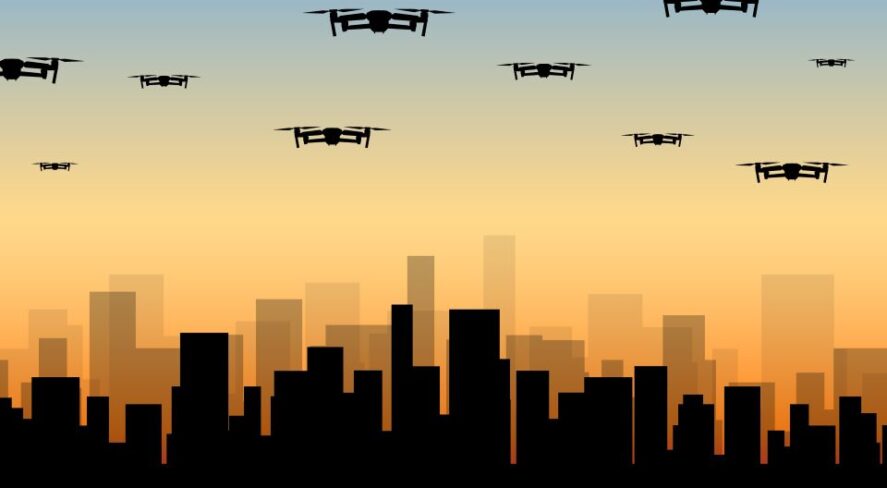Guest Post: sUAS and the Urban Fight

Building Intelligence’s Bill Edwards, Chair of the SIA Counter-UAS Working Group, Discusses How Tunnels Affect Drone Operations and Why Security Professionals Should Care

Operating, detecting and mitigating drones in a dense urban environment is not only hard but extremely complex. This is not only true for combat zones but can also include large city environments. Security professionals charged with protecting public space, specifically critical infrastructure and large mass gathering venues, should take some time to understand the difference between what the Israel-Hamas War and the Ukraine-Russia War have shown the world as it pertains to small uncrewed aircraft system (sUAS) operations and their impacts. Keep in mind that “key and complex terrain” exists in urban settings – power, water, communications and transportation nodes, to name a few. Let’s explore how this comparison works and the preventive steps that can be taken to support mitigating risk in these verticals.
Information, intelligence and weapons delivery are an integral part of successful combat operations and should be a concern for security professionals in the private sector. In modern conflict, especially with the convergence of Category 1-2 drones (drones less than 55 pounds) that have been inserted into the modern framework of combat operations, it is easy to see and justify why most of the operational intelligence and information and direct attack actions comes from drone technology. Since the Oct. 7, 2023, attack on Israel, which included various drone platforms, the debate has raged about subterranean warfare and the complications that come with that domain. Additionally, there have been several experts attempting to describe how the sUAS interacts in this environment. Simply put, drone operations from tunnel systems are challenging and some might say not viable.
Here’s why. Let’s take for example the Israeli offensive operation in Gaza. Past and recent reports on the tunnel system state that the network has been under constant construction for decades, is intricate in design, built with reinforced concrete and is at depths of 100 feet or more. So what does that mean? It means that technologies that rely on a specific communication backbone (drones not in an autonomous mode) will be ineffective in the type of environment described in this specific tunnel network, hence making drone operations from the tunnels a considerable challenge. Now compare this to the wide-open expansive battlefields in Ukraine, which provide for a different use case and example. As we’ve seen over the last 18 months, the war in Ukraine has proven to be a grand laboratory for drone experiments. Based on estimates that 70% of Russian causalities have come from drones in this open conflict with 1000s of kilometers of contested space it would seem the constricted environment of Gaza would even be more deadly but that may not be the case. In fact, drone operations in this case will benefit the offensive operations more in the urban fight and environment.
Let’s take a deeper look at the technology and why this is complex. It’s all about and comes down to communications. GPS and radio frequency attempting to emit and connect from a tunnel environment is nearly impossible. Take for example your cell phone. When you don’t have service in a specific area, it can be frustrating, but it is not uncommon. Normally, these dead zones have to do with tower placement and the ability of your device to find the signal and connect. Think about this from an operational perspective and an overcrowded, not to mention jammed electromagnetic spectrum situation. Additionally, this also means that drones flying in the tunnels as intelligence, surveillance and reconnaissance, or weapons delivery assets will have an equal level of complexity to achieve mission success. However, autonomy and artificial intelligence- (AI-)driven platforms have yet to be seen in this type of conflict and may emerge as a new factor for battlefield commanders and private security professionals to consider, but only time will tell.
Now let’s quickly look at other robotics and their possible uses and effects on tunnel defenses. Terrestrial robotics may be a good tool for inspection and reconnaissance before humans enter unknown spaces; however, they will be limited in range and countered by obstacles, and in warfare and nefarious acts against the public, innovation and creativity will emerge. In fact, the idea of ground robots armed as improvised explosive devices is one idea, but again they will need a communication connection to function properly. Stay tuned as the war progresses to see what will develop.
So, as a security professional in the private sector, there is much to consider when it comes to protecting your business and its patrons. The evolution of commercial drones is the technology that is “sneaking up” on security programs and is showing precipitous growth. The commercial drone platform and its implications (positive and negative) on security professionals and the concept of security program development have changed. The physical security perimeter now includes the “air domain,” and this is a daunting task to consider and undertake. Security professionals are at a point now where consideration for the “air domain” should be a major factor in their programs. Like the advent of cybersecurity and AI, commercial drones, through the lens of recent conflict zone actions have shown and proven that this technology is a security worry and creates risks that have not been addressed properly in the market space; however, there are frameworks available to support a security professional’s understanding and knowledge base to include easing the stress of “knowing” where to start.
There is a need for business owners and those responsible for security to have an appreciation of drone capabilities. Although this is still being nurtured in many forms, the security implications are moving faster than the environment can keep up. The journey of understanding how to mitigate the risk is a steep learning curve but achievable.
Lastly, there is an urgent need to address the current shortfalls in regulation and law surrounding drones, specifically the difficulties with the counter-uncrewed aircraft system (counter-UAS) technologies and authorities to implement them. The first step in this process is to have an open mind and to understand the technology, the current mitigation options and the restraints associated with counter-UAS based on the lack of authorities, regulations and laws. The second step is to seriously consider the “air domain” in the overall security program. The sUAS will only continue to grow, mature and evolve. It will put a significant amount of stress and pressure on businesses that host the public. Large mass gatherings will need to be secured and have the right authorities, training and certifications to implement a counter-UAS risk mitigation plan. Look no further than the wars of this time to realize “it’s time to look up.”
